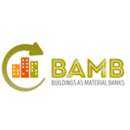Resource productivity
Definition
Resource productivity in the construction sector should be interpreted as the measure of the annual quantity of extracted virgin materials, in relation to the (economic) value created from this quantity.
Maximising resource productivity is one of the objectives when setting up a circular economy and using buildings as Material(s) Banks.
After all, it is expected that relatively more value will be created during the production of goods and the delivery of services if waste is avoided and materials are reused.
Guidelines
The proposed definition is adopted from the conventional definition of resource productivity by the European Commission, wherein the total Domestic Material Consumption is replaced by the quantity of extracted virgin materials. Consequently, this measure will increase if more materials are reused. This interpretation requires however further investigation.
Moreover, an increase in resource productivity, might indicate that a decoupling between the extraction of virgin materials and economic development takes place. This measure could change many mind-sets and make clear that well-being is not related to the level of material extraction and that lowering raw material use rates should not result in reduced economic development.
Further, note that ‘productivity’ is a measure of an economic activity, but not the activity itself.
References
Debacker W. and Manshoven S. (2016) Synthesis of the state-of-the-art BAMB report: Key barriers and opportunities for Materials Passports and Reversible Building Design in the current system. VITO.
Ellen MacArthur Foundation (2012) Towards the Circular Economy, an economic and business rationale for an accelerated transition. Cowes: Ellen MacArthur Foundation.
Eurostat (2016) Resource productivity – Statistics Explained. Retrieved March 2017, from http://ec.europa.eu/eurostat/statistics-explained/index.php/Glossary:Resource_productivity
Urban mining: recovering materials or assemblies of materials from the building stock instead of using virgin materials.
Rare earth elements: chemical elements found in the earth’s crust that are vital to many modern technologies but are difficult to find in quantities enabling their economic development.
--BAMB - Buildings As Material Banks 08:16, 15 Aug 2018 (BST)
Featured articles and news
CIOB report; a blueprint for SDGs and the built environment
Pairing the Sustainable Development Goals with projects.
Latest Build UK Building Safety Regime explainer published
Key elements in one short, now updated document.
UKGBC launch the UK Climate Resilience Roadmap
First guidance of its kind on direct climate impacts for the built environment and how it can adapt.
CLC Health, Safety and Wellbeing Strategy 2025
Launched by the Minister for Industry to look at fatalities on site, improving mental health and other issues.
One of the most impressive Victorian architects. Book review.
Common Assessment Standard now with building safety
New CAS update now includes mandatory building safety questions.
RTPI leader to become new CIOB Chief Executive Officer
Dr Victoria Hills MRTPI, FICE to take over after Caroline Gumble’s departure.
Social and affordable housing, a long term plan for delivery
The “Delivering a Decade of Renewal for Social and Affordable Housing” strategy sets out future path.
A change to adoptive architecture
Effects of global weather warming on architectural detailing, material choice and human interaction.
The proposed publicly owned and backed subsidiary of Homes England, to facilitate new homes.
How big is the problem and what can we do to mitigate the effects?
Overheating guidance and tools for building designers
A number of cool guides to help with the heat.
The UK's Modern Industrial Strategy: A 10 year plan
Previous consultation criticism, current key elements and general support with some persisting reservations.
Building Safety Regulator reforms
New roles, new staff and a new fast track service pave the way for a single construction regulator.
Architectural Technologist CPDs and Communications
CIAT CPD… and how you can do it!
Cooling centres and cool spaces
Managing extreme heat in cities by directing the public to places for heat stress relief and water sources.
Winter gardens: A brief history and warm variations
Extending the season with glass in different forms and terms.
Restoring Great Yarmouth's Winter Gardens
Transforming one of the least sustainable constructions imaginable.
























